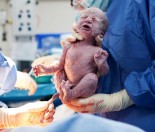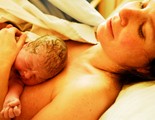This article provides an overview of Caesarean section – why they are performed and the risks and complications associated with Cesarean section.
If you want to read more about the operation, the before and after, what it involves and what it feels like, check out Caesarean in Detail.
Caesareans have become an almost common place way of giving birth today – while only 50 years ago it would have been quite unusual.
In 1984 the caesarean section rate in New Zealand was just 9.6%. By 2014 this had increased to 25% of all births in that year. And the actual figure could be even higher. The caesarean section rate at Auckland hospital was almost 35%.
The unusual name for this childbirth delivery procedure is linked to its history – it is associated with Julius Caesar, although it is highly unlikely that he was born this way, as his mother outlived him (in those days the operation was only done to save the baby when the mother had no chance of survival!).
There are several terms for the procedure – Caesarean, C section and Caesar. All refer to a Caesarean section and in your maternity notes you may see LSCS, which stands for Lower Section Caesarean Section.
So what is a Caesarean section, why would you have one and what are the risks and complications?
What is a Caesarean Section?
This is major abdominal surgery to deliver a baby (or babies) through the wall of the lower womb and abdomen.
Here are some common terms you will hear in relation to Caesareans:
- LSCS (a Lower Segment Caesarean Section) – usually in New Zealand today, the skin incision will be made just under the bikini line, through the abdominal muscle and then the lower segment of the womb.
- Classical incision – previously the incision was done down the centre of the abdomen, leaving a long scar and higher risk of complications.
- Elective Caesarean Sections are planned in advance and are done before labour has started.
- Emergency Caesarean Sections are done after labour has started when it proves difficult or impossible to deliver the baby through the birth canal.
- Crash Sections are done because of obstetric emergencies, such as haemorrhage or foetal distress when either the life of the mother, baby (or both) is at risk.
Why would I have a Caesarean Section?
There are many reasons why a woman may be advised or may choose to have an elective or emergency caesarean section. Each birth is unique and decisions should be made on an individual basis, involving women, their maternity professionals and their family/ whanau.
These are the most common reasons for caesarean sections in New Zealand today, the medical terms and their explanations:
- Fetal distress – the baby not coping with the labour (they get a reduced blood supply from the placenta during contractions, which most babies cope well with, but some do not).
- Failure to progress – despite contractions, the cervix does not open and the baby does not move down the mother’s pelvis.
- Mal presentations – the baby’s head is not coming first, it may be bottom first (breech) or shoulder first (this is rare).
- Haemorrhage – a dangerous amount of blood loss could occur in pregnancy (ante partum haemorrhage) or in labour (intra partum haemorrhage).
- Failed induction of labour – if the induction does not result in you going into labour, you could end up needing a Caesarean section. For further information see the Kiwi Families article on Induction of Labour.
- Obstetric emergencies – such as cord prolapse (the umbilical cord comes down in front of baby’s head, potentially cutting off the blood supply to baby) or rupture of the womb itself. Despite the impression we get from TV hospital dramas, these emergencies are uncommon.
- Previous caesarean section – which sometimes is an indication to plan a caesarean for the next birth.
- Problems in pregnancy such as severe pre-eclampsia – a disease of pregnancy which presents as raised blood pressure, protein in the urine and swelling of hands, feet and face, which may make labour inadvisable.
- Placenta praevia – the placenta is covering the opening at the bottom of the womb (the cervix) making it impossible to birth the baby vaginally.
- Previous complicated vaginal delivery – for example, if you have had a severe tear or difficult forceps delivery with a previous birth, a Caesarean section may be advisable.
What are the risks and complications of Caesarean Section?
Any operation has risks and complications, the main ones are:
- Haemorrhage – loss of a large amount of blood, sometimes requiring a blood transfusion.
- Infection – either transmitted during surgery or afterwards, requiring antibiotics.
- Blood clot or thrombosis – due to the immobility around the time of the operation.
- Wound breakdown – after the operation.
- Breathing problems -the baby has an increased risk of breathing problems if born by Caesarean section, as their lungs have not had some of the fluid squeezed out, as they do in vaginal birth.
Whilst the staff will do everything they can to minimise these risks, it is not possible to prevent them in all cases.
What can I do?
Firstly, minimise your chances of having a caesarean birth – keep fit and healthy, eat well and take advice from your Lead Maternity Carer in pregnancy about posture and baby positioning to aid a normal birth.
Ensure you have had the opportunity to explore your options for the birth with your health professionals; for example trying to avoid repeat caesarean sections, by attempting a vaginal birth first.
If you are anaemic in pregnancy (your routine blood tests will tell you this) ensure that you take your iron tablets, with vitamin C to help absorption, to prevent your risk of haemorrhage.
Stay mobile in labour as much as possible, to aid your labour and to prevent the complications of blood clots. Do gentle leg exercises and take deep breaths every ½ hour or so, if you are confined to bed.
Keep any wounds scrupulously clean and report any redness or swelling to your LMC immediately.
To read more about a caesarean section, and the pre and post op procedures, check out Caesarean in Detail. You’ll also want to take a look at the first 24 hours after a c-section. And we also provide information on vaginal birth after a caesarean section (VBAC).







Hi Everyone!… I am 42 years old and happy to have found out today we are/ I am pregnant.. I have 2 grown daughters (23 and 16 years old now!) I had C-sections with both 1. planed from week 30 – footling breech, after unsuccessfully trying to turn her 2. Emergency after 30hr’s of labor then our spines started grating! Both large babies over 9 pound – with 38cm heads.. I would imagine, after having 2 past C-Sections and now my age I will be possibly safer to elect C-Section, can any one tell me at what gestational age this… Read more »
Hi there. I’m just wondering if I’d be able to have a caeserian for my next baby as I had a very traumatic birth with my first, in short he turned out to be 10pound 14ounces, I had an adverse reaction to the pethidine, baby was posterior and I was in labour for 36 hours with 2hours pushing. I’m absolutely petrified of this happening again so don’t want to get pregnant again unless I can have a caeserian. Would this be something I could choose? Thanks
Hi Lily, Sounds like a very traumatic time! How tough! You’d be best to talk to your GP or an Obstetrician about this. Generally, if there is no medical reason for a caesarian, you would need to go privately with an Obstetrician. However, it may be that you have some grounds for one. You’d need to talk to a maternity care provider about this, though. Good luck!
Hi illy,
I would recommend that you see if there is a well trained, qualified Doula in your area. Talk to her. I sincerely believe you can have another vaginal birth with a positive experience. A doula may be another, less invasive and painful option for you to consider. Wishing you all the best!
hi dear , im a student and im going to apply for midwifery in the following year , I wanted to know , how cesarean is affecting all midwives, I mean is it causing loss of job for midwives. I need it for my assignment.
thank you
Following below is an article from the 2011 Annual Report of Otago Polytechnic. I would recommend searching their resources for more information. http://www.op.ac.nz/enterprise/research/ Place of birth Associate Professor Sally Baddock; Professor Sally Pairman The environments women choose to give birth in have a significant impact on the rates of intervention in labour and the type of births they will have. These are the findings of a recent study conducted by a multi-disciplinary team of researchers that included Otago Polytechnic School of Midwifery Co-Head, Associate Professor Sally Baddock, and Director of Learning and Teaching and Head of Midwifery, Baddock’s and Pairman’s… Read more »
I had my first child in the uk. I ended up having an emergency cesarian due to my cervix not dilating at all and it had been 48 hrs since my waters had broken. Is it likely that I will be able to manage a natural birth the second time as I have scar tissue. If so will I have to pay for a obs dr to perform the c section even if it is not elective?
Thanks
Hi Gem Vaginal birth after c-section (VBAC) is a safe option for the majority of women – and women considering their birthing options following c-section should have access from their LMC to research-based info regarding the outcomes of VBACs. Your LMC has a responsibility to discuss with you as part of your VBAC considerations: Reviewing the reason for previous c-section; any surgical complications, wound and general emotional-physical recovery; your options of place of birth and caregivers; and the option for a second opinion including a routine consultation referral with an Obstetrician. From the limited knowledge of your obstetric history, I ponder… Read more »